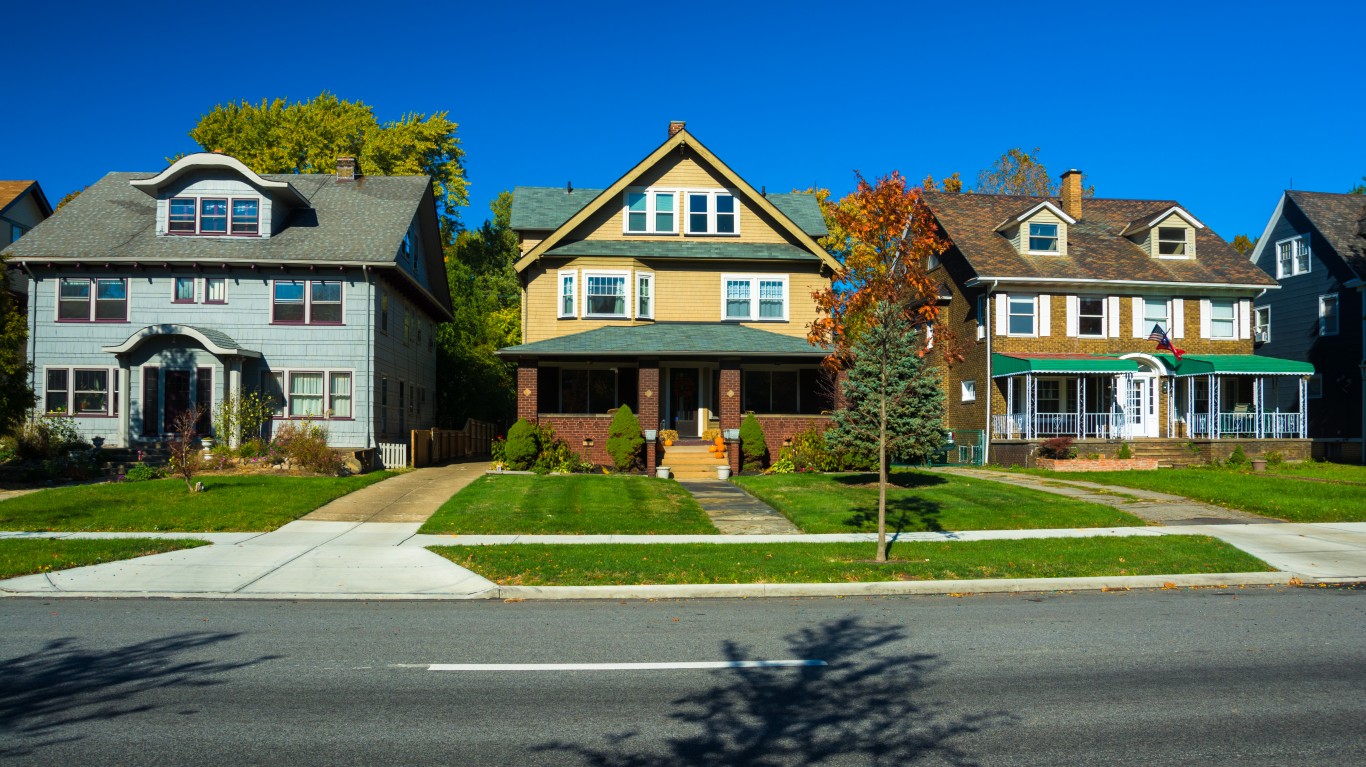 Since home prices peaked in the beginning of 2006, the U.S. median home price is down by a third. And though the market has begun to show signs of bottoming out, prices are still down nationally by 1.9% from last year and are expected to fall an additional 1% from the beginning of this year through 2013.
Since home prices peaked in the beginning of 2006, the U.S. median home price is down by a third. And though the market has begun to show signs of bottoming out, prices are still down nationally by 1.9% from last year and are expected to fall an additional 1% from the beginning of this year through 2013.
Read: Ten Towns That Cannot Turn Around
Of the 384 largest housing markets measured by real estate data company Fiserv, 69 have seen home prices fall more than the national average. 24/7 Wall St. reviewed the markets with the worst home price declines from their prerecession peak. Of those metro areas, we identified the markets where the median price did not improve in any of the periods measured by Fiserv as of the first quarter of 2012. The 10 worst are housing markets that have fallen at least 55% and have yet to recover.
While the drop in home prices in these markets has slowed, the local economies have been devastated. July unemployment rates in the worst housing markets were all above the national rate of 8.1%. Eight of the 10 have rates of at least 10%, and five are above 12%. Merced, Calif., one of the 10 worst-off cities, had an unemployment rate of 17.8% in July, the fourth-highest in the country.
According Fiserv chief economist David Stiff, the unemployment rates and languishing home prices in these markets are indicative of the underlying problems in these states as a whole. “The reason the job markets are so weak in these metro areas is that during the boom more than half of the growth was generated either directly or indirectly by residential real estate, and so now the reverse has happened,” Stiff explained.
Further evidence of the economic troubles heaped on these cities, three of the housing markets — San Bernardino, Vallejo and Stockton — have filed for bankruptcy since the recession began. Stockton’s Chapter 9 filing represents the largest such case in U.S. history.
Continually depressed home prices also have led to unusually high foreclosure rates in these markets. According to foreclosure data from RealtyTrac, a site that tracks housing data, these cities had among the worst foreclosure rates in the country as of the second quarter of 2012. Of the 10 cities, eight are among the 20 with the highest foreclosure rates out of the 212 metro regions with populations of 200,000 or more.
Of the cities with the worst home price declines, some have begun to recover. In the Detroit metro area, which did not make the list, the median home price has declined by 55.8% from the first quarter of 2006. However, between the first quarter of 2011 and the first quarter of 2012, the median price went up by 8.6%, one of the largest increases in the country.
Like Detroit, many of the the 10 worst-off markets appear to be about to recover because buyers see bargains. Home prices in seven of the 10 metro areas were lower than the national median of $159,000. Fiserv projects that of the 10 housing markets on our list, five will increase by more than the national rate of 5% between the first quarter of 2013 and the first quarter of 2014. This includes the Deltona-Daytona Beach-Ormond Beach region, which Fiserv projects will have more than 10% growth in median home value in that time. Stiff confirmed this: “investors, who were part of the problem back in the boom years will be trying to jump into these markets at a low.”
24/7 Wall St. reviewed data from Fiserv to determine the 10 metropolitan areas that had no annual improvement in their housing markets from the first quarter of 2007, the first quarter of 2009 and the first quarter of 2011, all through the first quarter of 2012. We relied on RealtyTrac for data on foreclosure rates and foreclosure sales (both for second quarter of 2012). We also obtained seasonally adjusted unemployment rates for July from the Bureau of Labor Statistics
These are the 10 towns that cannot turn around.
10. Deltona-Daytona Beach-Ormond Beach, Fla.
> Decline in home prices (peak to Q1, 2012): -55%
> Unemployment rate: 9.0% (107th highest)
> Median home price: $100,000 (20th lowest)
> Foreclosure rate: 1 in 185.4 housing units (57th highest)
Since reaching their peak in the first quarter of 2006, home prices in the Deltona-Daytona Beach-Ormond Beach area have consistently fallen. As of the first quarter of 2012, the area’s median home price had dropped 14.1% each year on average over the past five years. The median home price of $100,000 for the area was one of the nation’s lowest. Although homes have become highly devalued, causing the median mortgage payment to fall to just 8% of median income in 2012 from 22% at its peak, prices are expected to finally trend upward in the near future. Between the first quarter of 2012 and the first quarter of 2017, Fiserv projects home prices to rise 10% annually, one of the highest projected increases in the country.
9. Palm Coast, Fla.
> Decline in home prices (peak to Q1, 2012): -55%
> Unemployment rate: 12.3% (26th highest)
> Median home price: $117,000 (42nd lowest)
> Foreclosure rate: N/A
Between the first quarter of 2007 and the first quarter of 2012, home prices in Palm Coast fell at an annualized rate of 13.2%. Though home prices in the area have been falling for almost six years as of the first quarter of this year, since reaching peak price in the second quarter of 2006, a further 2.8% price decline is projected through the first quarter of 2013. The region’s deteriorating housing market has affected more than just home prices: Palm Coast’s 12.3% unemployment rate for July was four percentage points above that of the United States.
Also Read: States Losing the Most Jobs to China
8. Lakeland-Winter Haven, Fla.
> Decline in home prices (peak to Q1, 2012): -55.7%
> Unemployment rate: 9.8% (60th highest)
> Median home price: $104,000 (23rd lowest)
> Foreclosure rate: 1 in 112.8 housing units (17th highest)
From its pre-recession peak in 2006, home prices fell by more than 55% in the Lakeland-Winter Haven metro region, which is located in central Florida. This decline was worse than all but two housing markets in the state — the Punta Gorda metro region and the Cape Coral-Fort Myers area. But while both of those markets have already begun to recover, Lakeland has continued to fall through the first quarter of this year. Foreclosures in the region have skyrocketed recently, rising by 85% from the first quarter of 2011 through the first quarter of this year. The foreclosure rate in Lakeland — one in every 112.8 homes — was the 17th highest in the country.
7. Riverside-San Bernardino-Ontario, Calif.
> Decline in home prices (peak to Q1, 2012): -56.3%
> Unemployment rate: 12.2% (27th highest)
> Median home price: $180,000 (65th highest)
> Foreclosure rate: 1 in 68.3 housing units (2nd highest)
The Riverside-San Bernadino-Ontario metro area, known as the Inland Empire, is the eighth largest in the U.S. with over 4.3 million residents. Over the last five years, as of the first quarter of 2012, the median home price of the area’s more-than 1 million households has fallen, at an annualized rate of 14.7%. Falling home prices in Inland Empire have also been accompanied by foreclosures, as one in every 68.3 housing units in the area was in foreclosure as of the second quarter of this year, during which there were 21,996 foreclosures. On Aug. 1, the city of San Bernardino filed for bankruptcy.
6. Bakersfield-Delano, Calif.
> Decline in home prices (peak to Q1, 2012): -58.3%
> Unemployment rate: 13.9% (18th highest)
> Median home price: $121,000 (46th lowest)
> Foreclosure rate: 1 in 79.5 housing units (6th highest)
In the five years ending with the first quarter of 2012, the median price of a home in the Bakersfield-Delano area fell at an annualized rate of 15%. Though home prices fell just 0.8% in the most recent of these five years, Fiserv projects that homes will continue to lose value through the first quarter of 2013. However, there may be some positive news in the coming years as home prices are projected to rise 8.7% from the first quarter of 2013 through the first quarter of 2014. Still, Bakersfield-Delano faces significant problems. The area’s unemployment rate was 13.9% in July, or 5.6 percentage points above the national rate, and slightly more than one in every 80 homes was in foreclosure in the second quarter of this year. Interest in the area’s homes has been limited recently, as 46% of all sales were foreclosure sales in the second quarter and property listings in July were down almost 45% year-over-year.
5. Vallejo-Fairfield, Calif.
> Decline in home prices (peak to Q1, 2012): -60.1%
> Unemployment rate: 10.2% (56th highest)
> Median home price: $200,000 (47th highest)
> Foreclosure rate: 1 in 71.4 housing units (4th highest)
The Vallejo-Fairfield California metro area home price drop of more than 60% since the first quarter of 2006 was the sixth-worst decline during the housing market collapse of the 384 regions measured by Fiserv. Despite the decline, the area’s median home price was still in the top 15%, largely because the area contains California’s famous wine region, Napa Valley. Median family income was among the top 40 in the country at $76,100. Despite this, one in every 71.4 homes was in foreclosure as of the second quarter of this year, the fourth-highest rate in the country.
4. Las Vegas-Paradise, Nev.
> Decline in home prices (peak to Q1, 2012): -61.6%
> Unemployment rate: 11.7% (32nd highest)
> Median home price: $137,000 (79th lowest)
> Foreclosure rate: 1 in 95.9 housing units (11th highest)
No metropolitan area outside California has seen as large and unabated a home price decline as Las Vegas. While home prices in other metro areas on this list are expected to improve in the near future, home prices in Las Vegas are projected by Fiserv to decline through at least the first quarter of 2014. Home prices in the area are already low enough that the average discount for purchasing a foreclosed home was just 15.2%, less than half the 31.7% average discount nationwide.
Also Read: Cities with the Most Homes in Foreclosure
3. Stockton, Calif.
> Decline in home prices (peak to Q1, 2012): -62.8%
> Unemployment rate: 15.0% (12th highest)
> Median home price: $170,000 (76th highest)
> Foreclosure rate: 1 in 66.2 housing units (the highest)
When Stockton filed for bankruptcy in June, it became the largest-ever U.S. city to do so, according to The Wall Street Journal. The city’s economy has been plagued for years by constantly falling home prices, which declined at an annualized rate of 16.6% between the first quarter of 2007 and the first quarter of 2012. Stockton also has one of the nation’s highest unemployment rates of 15%, and a foreclosure rate that leads the nation with one in every 66.2 homes in foreclosure. Though Fiserv projects home prices will rise at an annualized rate of nearly 6% between the first quarter of 2012 and the first quarter of 2017, the housing market remains weak: 54% of all second-quarter home sales were foreclosure sales, and the number of property listings in July were down more than 40% year-over-year.
2. Modesto, Calif.
> Decline in home prices (peak to Q1, 2012): -64%
> Unemployment rate: 15.7% (9th highest)
> Median home price: $139,000 (83rd lowest)
> Foreclosure rate: 1 in 68.7 housing units (3rd highest)
Over the past five years Modesto’s median home price has fallen from 7.5 times median family income to just 2.5 times median family income. Though homes in the area have become more affordable, such price declines have devastated present and current homeowners. The area had the third-highest foreclosure rate in the nation at slightly higher than one in every 69 homes, and 57% of all homes sold were foreclosed properties. In few places has the economy been weakened by a housing collapse more than in Modesto, where the unemployment rate stood at 15.7%, the ninth highest rate nationwide.
1. Merced, Calif.
> Decline in home prices (peak to Q1, 2012): -69.7%
> Unemployment rate: 17.8% (4th highest)
> Median home price: $110,000 (32nd lowest)
> Foreclosure rate: 1 in 90.3 housing units (8th highest)
Nowhere in the U.S. have home prices taken the beating they have in Merced where the median price of a home has fallen at an annualized rate of 19.2% in the past five years, the highest rate in the country. Sadly, prices are not expected to begin to rise in 2012, as Fiserv predicts home prices will fall another 4.4% between the first quarter of 2012 and the first quarter 2013. Though home prices were possibly overvalued at their peak, when the median mortgage payment cost 51% of monthly income, they would appear to be undervalued now: the median mortgage payment costs just 10% of monthly income. The decline in home value has been especially costly for some homeowners, as one in every 90.3 homes was in foreclosure and 55% of all home sales were foreclosure sales. The massive decline in home prices has also caused significant damage to the local economy — the unemployment rate in Merced was 17.8%, higher than almost all other metropolitan areas.
-Michael B. Sauter and Alexander E. M. Hess
Also Read: American Cities Losing the Most Jobs
Get Ready To Retire (Sponsored)
Start by taking a quick retirement quiz from SmartAsset that will match you with up to 3 financial advisors that serve your area and beyond in 5 minutes, or less.
Each advisor has been vetted by SmartAsset and is held to a fiduciary standard to act in your best interests.
Here’s how it works:
1. Answer SmartAsset advisor match quiz
2. Review your pre-screened matches at your leisure. Check out the advisors’ profiles.
3. Speak with advisors at no cost to you. Have an introductory call on the phone or introduction in person and choose whom to work with in the future
Thank you for reading! Have some feedback for us?
Contact the 24/7 Wall St. editorial team.




